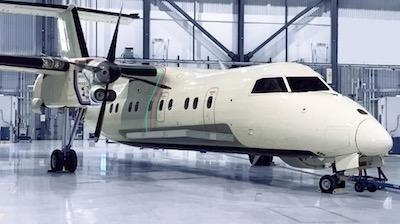Fri, Mar 29, 2019
'Project 804' Based On A Bombardier Dash 8 Airframe
United Technologies has released a white paper detailing what it calls "Project 804", the development of a hybrid-electric airliner.

The plane is an initiative of UTCs newly-established United Technologies Advanced Projects (UTAP)—a startup-like organization at the heart of UTC that disrupts from within. UTAP moves at intense speed to build and pilot ambitious product and service demonstrators, while simultaneously distilling UTC’s curious and collaborative culture.
The Project 804 X-plane will be based on a Bombardier Dash 8 Series -100 aircraft, re-engined on one side with a 2 megawatt-class propulsion system. Its configuration will consist of an engine optimized for cruise efficiency augmented by a battery-powered electric motor to assist during the missions’ 20-minute take off and climb.
The engine and electric motor will each generate about 1 megawatt of power in a parallel hybrid configuration. While the battery cells are off-the-shelf, the packaging and battery management system (BMS) are custom-designed for efficiency and to meet necessary safety requirements. This approach could be suitable for a clean-sheet regional design as well as a retrofitted option for existing airframes. The demonstrator’s novel architecture is expected to provide an industry-leading total fuel savings of at least 30% during an hour-long mission, with some of the fuel savings attributable to the latest in engine technology, not just the added electrification.
UTC believes the electrification of flight represents a significant opportunity for the industry, air travelers and the environment. By combining UTAP’s bold, risk-tolerant approach with UTC’s industrial roots and engineering expertise, Project 804 will make hybrid-electric flight a commercial reality with efficiency and speed.
According to the paper, a regional turboprop requires high take off power to carry large payloads but flies relatively slowly under relatively low power. Project 804 leverages this large ratio between peak power and steady-state power to create significant total energy savings. The propulsion system uses a 50/50 power split, parallel-hybrid configuration between an engine and an electric motor. The electrical assist is high-power and short-duration allowing the size and weight of the energy storage device to be manageable within the aircraft maximum takeoff weight. The configuration also allows the engine to be optimized for the cruise portion of the flight only. Full system capability is within the 2MW power class for the 30-50 passenger regional turboprop market.
(Image from UTC White Paper)
More News
“Sport Pilot 2.0 gives more people than ever the opening to pursue their dreams of putting themselves in the pilot seat and enjoying the unique perspectives of flight. This v>[...]
Aero Linx: Canadian Business Aviation Association (CBAA) The Canadian Business Aviation Association (CBAA) is a non-profit association formed in 1961 as Canada's voice for business>[...]
Make Sure You NEVER Miss A New Story From Aero-News Network Do you ever feel like you never see posts from a certain person or page on Facebook or Instagram? Here’s how you c>[...]
From 2023 (YouTube Edition): Acme Aerofab Black Ops Gear and Suspension Impress The viability of a backcountry aircraft is a function of numerous purpose-built components and syste>[...]
Also: SkyFly’s Axe Prototype, USAF CCA, AV Expands Switchblade, DropShip Cargo Drone Air New Zealand has taken its first big step toward electric aviation, flying the US-buil>[...]
 Aero-News: Quote of the Day (10.23.25)
Aero-News: Quote of the Day (10.23.25) ANN's Daily Aero-Linx (10.23.25)
ANN's Daily Aero-Linx (10.23.25) ANN FAQ: Turn On Post Notifications
ANN FAQ: Turn On Post Notifications Classic Aero-TV: Kitfox Upgrades Back-Country Undercarriage
Classic Aero-TV: Kitfox Upgrades Back-Country Undercarriage Airborne-NextGen 10.21.25: NZ Goes Electric, World Cup UAVs, eAviation Shuttered
Airborne-NextGen 10.21.25: NZ Goes Electric, World Cup UAVs, eAviation Shuttered



